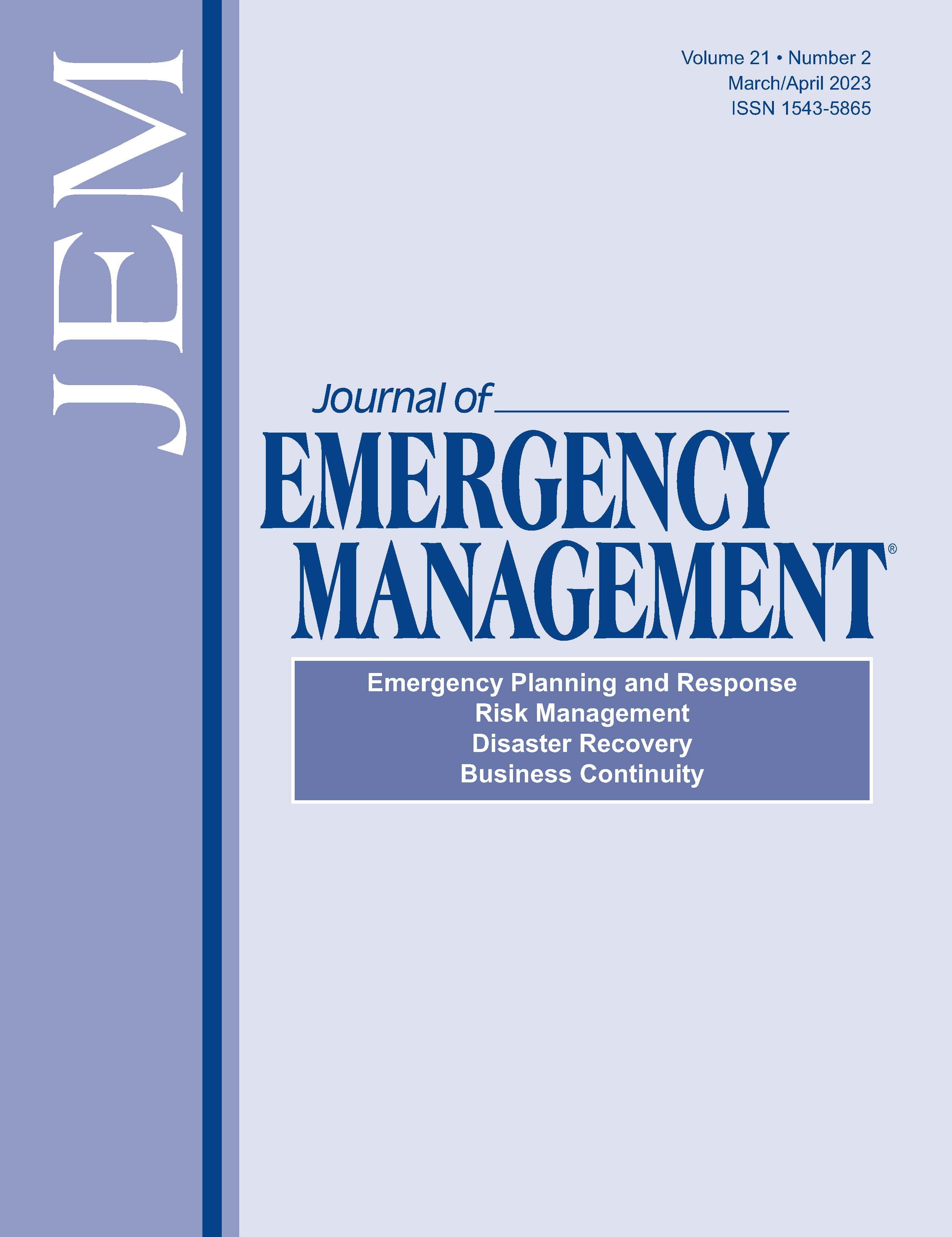Ready or not: Emergency preparedness in residential care facilities for the elderly (RCFE) in California
DOI:
https://doi.org/10.5055/jem.0770Keywords:
emergency preparedness, residential care facilities for the elderly, long-term care, COVID-19, public health, older adultsAbstract
This study examined the results of an electronic survey of residential care facilities for the elderly (RCFE) in California in 2021 to provide insight on key elements of emergency plans and facility preparedness for the COVID-19 pandemic and future emergencies.
Surveys were distributed to RCFE administrators using publicly available emails found on the California Health and Human Services Open Data Portal. Responses from 150 facility administrators included data on their perception of current and future facility preparedness for COVID-19 and other emergency scenarios, items included in facility evacuation/shelter-in-place plans, and hazard vulnerability analyses and training practices of facility staff. Descriptive analyses were performed on collected data.
The majority of results were from small facilities serving less than seven residents (70.7 percent). Prior to COVID-19, more than 90 percent of respondents included disaster drills, evacuation plans, and emergency transportation in their emergency preparedness plan. The majority of facilities added pandemic planning, vaccine distribution, and quarantine guidelines elements into their plans during COVID-19. Approximately half of facilities reported conducting proactive hazard vulnerability analyses. Around 75 percent of RCFEs felt well prepared for fires and infectious disease outbreaks, had mixed preparedness levels for earthquakes and floods, and felt least prepared for landslides and active shooter emergencies. During the pandemic, perceptions of preparedness rose, with 92 percent stating they felt very prepared currently and almost 70 percent felt very prepared for future pandemics.
Preparedness of these essential facilities and their residents can continue to improve by conducting regular proactive hazard vulnerability analyses, improving communication lines and mutual aid agreements with local and state organizations, and preparing for critical emergencies such as landslides and active shooter scenarios. This can help to ensure adequate resources and investments are provided to care for older adults during emergencies.
References
Schröder-Butterfill E, Marianti R: A framework for understanding old-age vulnerabilities. Ageing Soc. 2006; 26(1): 9-35.
US Department of Health and Human Services Centers for Disease Control and Prevention: COVID-19 recommendations for older adults. Available at https://www.cdc.gov/aging/covid19/index.html. Accessed May 28, 2022.
Thomas KS, Zhang W, Dosa DM, et al.: Estimation of excess mortality rates among US assisted living residents during the COVID-19 pandemic. JAMA Network Open. 2021; 4(6): e2113411.
Chidambaram P, Garfield R, Neuman T: COVID-19 has claimed the lives of 100,000 long-term care residents and staff. Kaiser Family Foundation. 2020. Available at https://www.kff.org/policywatch/covid-19-has-claimed-the-lives-of-100000-long-term-careresidents-and-staff/. Accessed February 4, 2021.
Adalja AA, Toner E, Inglesby TV: Priorities for the US health community responding to COVID-19. J Am Med Assoc. 2020; 323(14): 1343-1344.
Davidson PM, Szanton SL: Nursing homes and COVID-19: We can and should do better. J Clin Nurs. 2020; 29: 2758-2759.
California Assisted Living Association: RCFEs by the numbers. Available at http://caassistedliving.org/about-assisted-living/assisted-living-in-california/assisted-living-by-numbers. Accessed June 7, 2022.
California Health and Human Services Open Data Portal: Community Care Licensing—Residential elder care facility locations. Available at https://data.chhs.ca.gov/dataset/community-care-licensing-residential-elder-care-facility-locations. Accessed May 25, 2021.
Hagen J: Protecting the elderly in times of disaster: The critical need for comprehensive disaster planning and exercise design. Forum Public Policy. 2006; 2007(3). Available at: https://www.forumonpublicpolicy.co.uk/_files/ugd/553e83_4101ebbe2a774064a7cdc36e8ab18461.pdf. Accessed February 3, 2023.
Volkman JC, Rebmann T, Hilley S, et al.: Infection prevention disaster preparedness planning for long-term care facilities. Am J Infect Control. 2012; 40(3): 206-210.
Kramer AM, Kowalsky JC, Lin M, et al.: Outcome and utilization differences for older persons with stroke in HMO and fee-for-service systems. J Am Geriatr Soc. 2000; 48(7): 726-734.
Selod S, Heineman J, O’Brien C, et al.: Long-term care and disaster preparedness: A study of organizational types and levels of preparedness for a disaster or emergency. J Emerg Manag. 2011; 9(2): 39.
Kennedy KA, Hua CL, Nelson I: A comparison of emergency preparedness policies by long-term care setting type in Ohio: Assisted living settings lag behind nursing homes in key areas. J Appl Gerontol. 2020; 40(4): 377-386.
Lum HD, Mody L, Levy CR, et al.: Pandemic influenza plans in residential care facilities. J Am Geriatr Soc. 2014; 62(7): 1310-1316.
Usher K, Durkin J, Gyamfi N, et al.: Preparedness for viral respiratory infection pandemic in residential aged care facilities: A review of the literature to inform post-COVID-19 response. J Clin Nurs. 2021.
Siu HYH, Kristof L, Elston D, et al.: A cross-sectional survey assessing the preparedness of the long-term care sector to respond to the COVID-19 pandemic in Ontario, Canada. BMC Geriatr. 2020; 20(1): 1-9.
California Residential Care Facilities for the Elderly Emergency and Disaster Plan, Health and Safety Code div. 2 Ch. 3.2 article 6 S 1569.695: Available at https://leginfo.legislature.ca.gov/faces/codes_displaySection.xhtml?sectionNum=1569.695.&lawCode=HSC. Accessed June 7, 2022.
Powell T, Hanfling D, Gostin LO: Emergency preparedness and public health the lessons of hurricane sandy. J Am Med Assoc. 2012; 308(24): 2569-2570.
Ratzan SC, Sommarivac S, Rauh L: Enhancing global health communication during a crisis: Lessons from the COVID-19 pandemic. Public Health Res Practice. 2020; 30(2): e3022010.
Seale GS: Emergency preparedness as a continuous improvement cycle: Perspectives from a postacute rehabilitation facility. Rehabil Psychol. 2010; 55(3): 247-254.
The Violence Project: Mass shooter database. Available at https://www.theviolenceproject.org/mass-shooter-database. Accessed June 7, 2022.
US Department of Health and Human Services Office of the Assistant Secretary for Preparedness and Response: Cultural and linguistic competency in disaster preparedness and response fact sheet. Available at https://www.phe.gov/Preparedness/planning/abc/Pages/linguistic-facts.aspx. Accessed May 20, 2022.
Published
How to Cite
Issue
Section
License
Copyright 2007-2025, Weston Medical Publishing, LLC and Journal of Emergency Management. All Rights Reserved.
Leave Nobody Behind: Emergency Management in a More Inclusive Way is a trademark of Journal of Emergency Management






